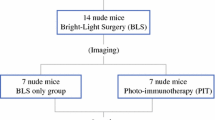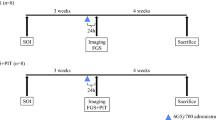Abstract
Background
The prognosis for patients with liver metastases from colorectal carcinoma is limited because of the low number of patients who are eligible for curative hepatic resection. In this phase I study, 31 liver metastases in 24 patients with nonresectable metastases from colorectal carcinoma were treated with photodynamic therapy (PDT).
Methods
The photosensitizer 5,10,15,20-tetrakis(m-hydroxyphenyl)bacteriochlorin (mTHPBC) was intravenously administered in a dose of .6 mg/kg (n = 12) or .3 mg/kg (n = 12). After 120 hours (n = 18) or 48 hours (n = 6), tumors were illuminated for 300 to 600 seconds through percutaneously inserted optical fibers with a light dose of 60 J/cm of diffuser (740 nm).
Results
Tumor necrosis at 1 month after PDT was achieved in all treated lesions. Laser treatment was associated with mild pain (n = 8) and transient subclinical hepatotoxicity (n = 21). In one patient, PDT damage to the pancreas was inflicted, and in another patient, PDT damage of the skin occurred, but no serious clinical complications from PDT were reported. Administration of .6 mg/kg of mTHPBC led to transient phlebitis in 10 patients, and 3 patients experienced mild skin phototoxicity after excess light exposure.
Conclusions
Colorectal liver metastases that are ineligible for resection can be safely and effectively treated with interstitial mTHPBC-based PDT.




Similar content being viewed by others
References
Boyle RW, Dolphin D. Structure and biodistribution relationships of photodynamic sensitizers. Photochem Photobiol 1996;64:469–85
Bugelski PJ, Porter CW, Dougherty TJ. Autoradiographic distribution of hematoporphyrin derivative in normal and tumor tissue of the mouse. Cancer Res 1981;41:4606–12
Fingar VH. Vascular effects of photodynamic therapy. J Clin Laser Med Surg 1996;14:323–8
Korbelik M. Induction of tumor immunity by photodynamic therapy. J Clin Laser Med Surg 1996;14:329–34
Dougherty TJ, Cooper MT, Mang TS. Cutaneous phototoxic occurrences in patients receiving Photofrin. Lasers Surg Med 1990;10:485–8
Ackroyd R, Kelty CJ, Brown NJ, Stephenson TJ, Stoddard CJ, Reed MW. Eradication of dysplastic Barrett’s oesophagus using photodynamic therapy: long-term follow-up. Endoscopy 2003;35:496–501
Moghissi K, Dixon K, Thorpe JA, Stringer M, Moore PJ. The role of photodynamic therapy (PDT) in inoperable oesophageal cancer. Eur J Cardiothorac Surg 2000;17:95–100
Ortner M. Photodynamic therapy for cholangiocarcinoma. J Hepatobiliary Pancreat Surg 2001;8:137–9
Waidelich R, Stepp H, Baumgartner R, Weninger E, Hofstetter A, Kriegmair M. Clinical experience with 5-aminolevulinic acid and photodynamic therapy for refractory superficial bladder cancer. J Urol 2001;165:1904–7
van Hillegersberg R, Marijnissen JP, Kort WJ, Zondervan PE, Terpstra OT, Star WM. Interstitial photodynamic therapy in a rat liver metastasis model. Br J Cancer 1992;66:1005–14
Purkiss SF, Dean R, Allardice JT, Grahn MF, Williams NS. An interstitial light delivery system for photodynamic therapy within the liver. Lasers Med Sci 1993;8:253–7
Purkiss SF, Grahn MF, Abulafi AM, Dean R, Allardice JT, Williams NS. Multiple fiber interstitial photodynamic therapy of patients with colorectal liver metastases. Lasers Med Sci 1994;9:27–35
Hara N, Ichinose Y, Motohiro A, Ohta M, Yagawa K. Distribution of hematoporphyrin derivative in normal and malignant tissue. Jpn J Exp Med 1988;58:139–43
Copper MP, Tan IB, Oppelaar H, Ruevekamp MC, Stewart FA. Meta-tetra(hydroxyphenyl)chlorin photodynamic therapy in early-stage squamous cell carcinoma of the head and neck. Arch Otolaryngol Head Neck Surg 2003;129:709–11
Rovers JP, de Jode ML, Grahn MF. Significantly increased lesion size by using the near-infrared photosensitizer 5,10,15,20-tetrakis (m-hydroxyphenyl)bacteriochlorin in interstitial photodynamic therapy of normal rat liver tissue. Lasers Surg Med 2000;27:235–40
Yow CM, Chen JY, Mak NK, Cheung NH, Leung AW. Cellular uptake, subcellular localization and photodamaging effect of temoporfin (mTHPC) in nasopharyngeal carcinoma cells: comparison with hematoporphyrin derivative. Cancer Lett 2000;157:123–31
Rovers JP, Saarnak AE, Molina A, Schuitmaker JJ, Sterenborg HJ, Terpstra OT. Effective treatment of liver metastases with photodynamic therapy, using the second-generation photosensitizer meta-tetra(hydroxyphenyl)chlorin (mTHPC), in a rat model. Br J Cancer 1999;81:600–8
Rovers JP, de Jode ML, Rezzoug H, Grahn MF. In vivo photodynamic characteristics of the near-infrared photosensitizer 5,10,15,20-tetrakis(M-hydroxyphenyl) bacteriochlorin. Photochem Photobiol 2000;72:358–64
Rovers JP, Saarnak AE, de Jode M, Sterenborg HJ, Terpstra OT, Grahn MF. Biodistribution and bioactivity of tetra-pegylated meta-tetra(hydroxyphenyl)chlorin compared to native meta-tetra(hydroxyphenyl)chlorin in a rat liver tumor model. Photochem Photobiol 2000;71:211–7
Green S, Weiss GR. Southwest Oncology Group standard response criteria, endpoint definitions and toxicity criteria. Invest New Drugs 1992;10:239–53
Goldberg SN, Charboneau JW, Dodd GD III, et al. Image-guided tumor ablation: proposal for standardization of terms and reporting criteria. Radiology 2003;228:335–45
Green S, Weiss GR. Southwest Oncology Group standard response criteria, endpoint definitions and toxicity criteria. Invest New Drugs 1992;10:239–53
Wagnieres G, Hadjur C, Grosjean P, et al. Clinical evaluation of the cutaneous phototoxicity of 5,10,15,20-tetra(m-hydroxyphenyl)chlorin. Photochem Photobiol 1998;68:382–7
Lustig RA, Vogl TJ, Fromm D, et al. A multicenter phase I safety study of intratumoral photoactivation of talaporfin sodium in patients with refractory solid tumors. Cancer 2003;98:1767–71
Chen J, Keltner L, Christophersen J, et al. New technology for deep light distribution in tissue for phototherapy. Cancer J 2002;8:154–63
Parikh AA, Curley SA, Fornage BD, Ellis LM. Radiofrequency ablation of hepatic metastases. Semin Oncol 2002;29:168–82
Curley SA. Radiofrequency ablation of malignant liver tumors. Ann Surg Oncol 2003;10:338–47
Solbiati L, Goldberg SN, Ierace T, et al. Hepatic metastases: percutaneous radio-frequency ablation with cooled-tip electrodes. Radiology 1997;205:367–73
Mack MG, Straub R, Eichler K, et al. Percutaneous MR imaging-guided laser-induced thermotherapy of hepatic metastases. Abdom Imaging 2001;26:369–74
Vogl TJ, Mack MG, Straub R, Roggan A, Felix R. Magnetic resonance imaging–guided abdominal interventional radiology: laser-induced thermotherapy of liver metastases. Endoscopy 1997;29:577–83
Lu DS, Raman SS, Vodopich DJ, Wang M, Sayre J, Lassman C. Effect of vessel size on creation of hepatic radiofrequency lesions in pigs: assessment of the “heat sink” effect. AJR Am J Roentgenol 2002;178:47–51
Author information
Authors and Affiliations
Corresponding author
Additional information
Published by Springer Science+Business Media, Inc. © 2005 The Society of Surgical Oncology, Inc.
Rights and permissions
About this article
Cite this article
van Duijnhoven, F.H., Rovers, J.P., Engelmann, K. et al. Photodynamic Therapy With 5,10,15,20-Tetrakis(m-Hydroxyphenyl) Bacteriochlorin for Colorectal Liver Metastases Is Safe and Feasible: Results From a Phase I Study. Ann Surg Oncol 12, 808–816 (2005). https://doi.org/10.1245/ASO.2005.09.005
Received:
Accepted:
Published:
Issue Date:
DOI: https://doi.org/10.1245/ASO.2005.09.005




